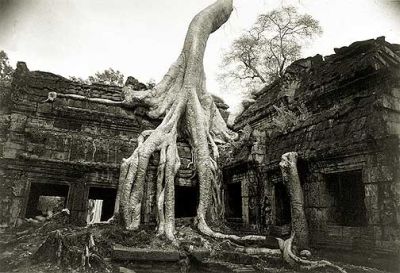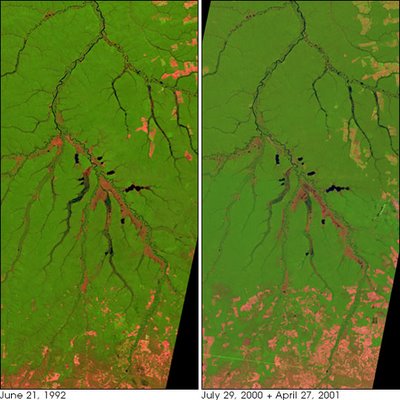 [Image: Angkor Wat, Cambodia, a city reclaimed by the roots of trees; photographed by Kenro Izu].
[Image: Angkor Wat, Cambodia, a city reclaimed by the roots of trees; photographed by Kenro Izu].I just finished reading a long and totally fascinating article by David Grann called "The Lost City of Z," from an old issue of The New Yorker.
In it, Grann explores whether or not a city called "Z" might exist somewhere in the Brazilian rain forest – "a region nearly the size of the continental United States" – while tracking the life of a British explorer, Colonel Percy Harrison Fawcett, who "disappeared in the forest, along with his son and another companion" in 1925.
"Fawcett had been acclaimed as one of the last great amateur archeologists and cartographers," Grann writes, "men who ventured into uncharted territories with little more than a machete, a compass, and an almost divine sense of purpose." Colonel Fawcett believed that, "in the southern basin of the Amazon, between the Tapajós and the Xingu tributaries," lay Z, a ruined city lost to the jungles of time.
"To bolster his case that the ruins of Z would be found in the region," Grann tells us, Fawcett "cited carvings that he had seen on rocks in the area, and documents that he had uncovered from Portuguese conquistadores in Brazilian archives. He quoted a Brazilan scholar, who declared, 'My studies have convinced me that... there may yet be found in our forests, as yet penetrated in few places, ruins of ancient cities.'"
Because of Fawcett's disappearance, however, at least 100 other explorers have lost themselves in the Amazon, looking for his remains (or, more likely, looking for Z). There was, of course, one crucial problem: Fawcett, funded by the Royal Geographical Society, kept his expeditionary path completely secret, even releasing false latitudinal coordinates for fear that someone else might steal the final prize: discovering, mapping, and documenting Z. Fawcett was exploring at "the peak of the British Empire," we read, "a time when the English were constantly confronting and colonizing new, exotic civilizations; when imperial explorers such as David Livingstone were trying to map the so-called 'dark continent' of Africa; and when the Allan Quartermain novels by Fawcett's friend H. Rider Haggard, which chronicle the intrepid adventurer's discovery of ancient civilizations in Africa, were wildly popular." The last thing he needed, in other words, was another explorer hot on his trail.
To make a (very) long story short, David Grann – the article's author – visits Colonel Fawcett's granddaughter in Cardiff, Wales, whereupon Grann discovers unpublished letters from Fawcett that reveal the expedition's true route through the jungle. Thus Grann sets off for Brazil.
More and more information about Fawcett pops up. "One day, during a visit to a colonial archive in Rio de Janeiro," Grann reports, "Fawcett discovered a document, partly eaten by worms, that was titled 'Historical account of a large, hidden, and very ancient city, without inhabitants, discovered in the year 1753.'" Within the document, Grann tells us, Fawcett learned about a Portuguese "soldier of fortune," who, along with his expeditionary team, "ascended a mountain path" to find "a spellbinding vista: below them were the ruins of an ancient city. The men climbed down, and discovered stone arches, a statue, wide roads, and a temple with hieroglyphics." Reading the account, Fawcett "became even more entranced with the idea of a lost civilization" – and, presumably, so did Grann.
Now in Brazil, Grann – carefully tracking Fawcett's final self-enforestation – is taken by a guide to the ruins of an enormous ranch built deep in what used to be jungle; what he sees there shocks him: "The farm had been consumed by jungle in just a few decades, and I wondered how actual ancient ruins could possibly survive in such a hostile environment. For the first time, I had some sense of how it might be possible for the remnants of a civilization simply to disappear."
Several pages ensue in which Grann hears contradictory tales of a kidnapped white man paraded through the territories of various tribes back in the 1930s; albino children; "very bad Indians"; and "a colossal man," named Afukaká, "his arms as thick as legs, his legs as big as a chest."
But then my eyes started popping out of my head, because here Grann meets Michael Heckenberger, a "highly regarded professor at the University of Florida," who was doing field work in the upper Xingu basin.
 [Image: NASA, satellite views of Brazil's Xingu National Park].
[Image: NASA, satellite views of Brazil's Xingu National Park].Prof. Heckenberger "had battled everything from malaria to snakes to virulent bacteria that made his skin peel off and forced him to boil his garments twice a day." He looked "a little like a surfer." Familiar with Fawcett's story, the archaeologist then turns to Grann and says: "I want to show you something." He grabs a machete and they walk together, more than a mile into the forest, "cutting away tendrils from trees, which shot upward, fighting for the glow of the sun."
Then Heckenberger stops. He gestures at the ground: it's sloping. Why is it sloping?
It used to be a moat.
"What do you mean, a moat?" Grann asks.
"A moat," Heckenberger answers. "A defensive ditch." It's nearly a mile in diameter and more than 900 years old.
Heckenberger then shows Grann some excavation pits, where foundations of "palisade walls" are found, half-buried in black soil.
Turns out the group of them are standing in "the remains of a massive man-made landscape. There was not just one moat but three, arranged in concentric circles. There was a giant circular plaza where the vegetation had a different character than that of the rest of the forest, because it had once been swept clean. And there had been a sprawling neighborhood of dwellings, as evidenced by even denser black soil, which had been enriched by decomposed garbage and human waste."
There were also the remains, Heckenberger explains, of "Roads. Causeways. Canals."
So is it the city of Z? Or is Z still out there, waiting?
No comments:
Post a Comment